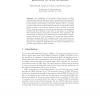Free Online Productivity Tools
i2Speak
i2Symbol
i2OCR
iTex2Img
iWeb2Print
iWeb2Shot
i2Type
iPdf2Split
iPdf2Merge
i2Bopomofo
i2Arabic
i2Style
i2Image
i2PDF
iLatex2Rtf
Sci2ools
ECIR
2007
Springer
2007
Springer
Feature- and Query-Based Table of Contents Generation for XML Documents
The availability of a document’s logical structure in XML retrieval allows retrieval systems to return document portions (elements) instead of whole documents. This helps searchers focusing their attention to the relevant content within a document. However, other, e.g. sibling or parent, elements of retrieved elements may also be important as they provide context to the retrieved elements. The use of table of contents (TOC) offers an overview of a document and shows the most important elements and their relations to each other. In this paper, we investigate what searchers think is important in automatic TOC generation. We ask searchers to indicate their preferences for element features (depth, length, relevance) in order to generate TOCs that help them complete information seeking tasks. We investigate what these preferences are, and what are the characteristics of the TOCs generated by searchers’ settings. The results have implications for the design of intelligent TOC generation...
| Added | 29 Oct 2010 |
| Updated | 29 Oct 2010 |
| Type | Conference |
| Year | 2007 |
| Where | ECIR |
| Authors | Zoltán Szlávik, Anastasios Tombros, Mounia Lalmas |
Comments (0)

